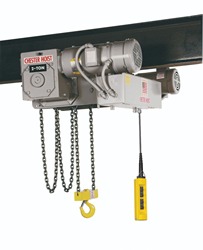How to Understand Grades of Chains & Applications
 Chains have been used for all kinds of tasks from 225 BC to today. With so many different types of chain on the market, how do we know if we’re using the correct grade of chain for our projects? The first step is becoming familiar with chain grades, chain ratings and what they mean.
Chains have been used for all kinds of tasks from 225 BC to today. With so many different types of chain on the market, how do we know if we’re using the correct grade of chain for our projects? The first step is becoming familiar with chain grades, chain ratings and what they mean.
Chain Grades
Graded chain is engineered to meet criteria for specific applications determined by:
- The task
- Weight limits
- Location
There are five grades of chain in common use: Grade 30, Grade 43, Grade 70, Grade 80, and Grade 100.
But what do these grades mean?
Chain grades indicate the tensile strength in N/mm and what type of material is used to manufacture it. The tensile strength of a chain is based on its ultimate breaking strength. The force at which the chain breaks in tension (in units of N) is divided by the area of two crosssections of a single link (in units of mm).
The grade as advertised by chain manufacturers is 1/10 of the actual ultimate strength, which means Grade 70 chain has an ultimate breaking strength of 700 N/mm (or 101,526 psi). Based on this, it makes sense that higher grade chains are going to be stronger and harder.
Chain Finishes
As we discuss the different grades of chain in a moment, you’ll notice that there are specific finishes available for each chain. Here’s a quick summary of what they mean:
- Self-colored: no finish or coating
- Black zinc: zinc-plated that is black or gray passivated to give it color; usually matte to reduce reflection and glare
- Bright galvanized: thin coating of zinc mixed with aluminum to give it a bright (or shiny) finish
- Zinc plated: thin coating of zinc deposited on the chain that provides minimal protection against corrosion unless a clear zinc coating is applied on top; may look silver or have a slight blue tint
- Yellow chromate: chromate applied to the chain after it has been zinc plated; provides excellent corrosion protection
Grade 30 (System 3) Proof Coil Chain
Grade 30 chain (also called G30 chain or common coil chain) is an excellent general-purpose chain of standard commercial quality. It is frequently used for fabricating tow chains, binding or tie down chains, and logging chains.
The standard material used in Grade 30 chain is low carbon steel. The available finishes for G30 chain are self-colored, galvanized, zinc-plated and poly coated. This chain is proof tested and should NOT be used in overhead lifting. This grade of chain ranges in diameter from 1/8” up to 3/4” and is embossed using a 3, 30, or 300 for traceability purposes.
Grade 43 (System 4) High Test Chain
Grade 43 chain (G43 of G-4) is designed for use in load binding, towing, logging, and other applications requiring high strength. It is made from carbon steel and is available in bright galvanized or zinc-plated finishes. Grade 43 chain is proof tested and should NOT be used in overhead lifting. This type of chain ranges in size from 1/4” to 3/4” in diameter.
Grade 70 (System 7) Transport Chain
Grade 70 chain (G70) is used in load binding, towing, and logging and can be used in accordance with Department of Transportation regulations. The standard material used to manufacture these chains is heat treated carbon steel with no alloying elements included. The available finishes are corrosion-resistant zinc electroplate with yellow chromate conversion coating, which also makes them easy to spot. Grade 70 chain is proof tested and should NOT be used in overhead lifting. Note that this type of chain is available in sizes from 1/4” to 1/2” in diameter.
Grade 80 (System 8) CAM-Alloy Chain
Grade 80 chain (HA800) is specifically recommended for overhead lifting and is a more economical choice compared to Grade 100 (which we’ll talk about in a moment). Grade 80 is manufactured from heat treated alloy steel with a bright galvanized finish. Like the other chains discussed here, Grade 80 is proof tested. The size of the Grade 80 chain ranges from 7/32” to 1-1/4” in diameter.
Grade 100 (System 10) CAM-Alloy Chain
Grade 100 chain (HA1000 or System 10) is specifically recommended for overhead lifting and is 25% stronger than Grade 80 chain. This chain enables you to perform the same lifts with a lighter weight chain and is most typically used in construction, rigging, and manufacturing. Grade 100 is manufactured from heat treated alloy steel, is proof tested, and its standard finish is bright. Note that Grade 100 chain should never be plated. Its sizes range from 9/32” to 7/8” in diameter.
Stainless Steel Chain
Stainless steel chain is used in food processing and chemical and marine application, as well as applications where non-magnetic, electrically welded corrosion resistant chain is needed. It is manufactured from type 316L stainless steel with a bright finish. Stainless steel chain is proof tested and should NOT be used for overhead lifting. It is available in sizes from 5/32” up to 3/8” in diameter.
Aluminum Chain
Aluminum chain is used in chemical processing, petroleum refining, food processing, landscaping, and crowd control, as well as applications needing a non-magnetic, non-sparking application. It is manufactured from a 5056 aluminum-magnesium alloy, and the standard finish is bright. Note that aluminum chain is proof tested and is NOT for use in overhead lifting or dynamic load conditions. Available sizes range from 17/64” up to 5/16” in diameter.
Conclusion
Now that you understand the differences in the various grades of chain, you can work safely and choose the correct chain for your application. And if you are looking for high quality chains, hooks, and slings, or have questions about what you need, contact us here at Hi-Speed Industrial. Our experts will be more than happy to help you find what you need.

